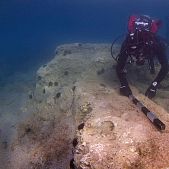
Impressive findings in ancient port of Lechaion near Corinth
Impressive findings were revealed at the ancient port of Corinth in Lechaion in Peloponnese. The Ministry of Culture announced the findings and released photographs of the research in the area.
The submerged ancient port covered a total area of 2,750 square meters. It ran 911 meters along the modern Corinth Gulf coastline and the entrance channel to the port lay on the harbor’s eastern part. The channel is 8.9 meters wide while a western and a middle mole were also found west of it. At the entrance channel, eight caissons or watertight retaining structures were found, filled with small and medium sized pebbles mixed with mortar made for marine structures. These unique structures, found nowhere else in Greece, point to plans to expand the port by adding another mole. The sidearms entry depicted in length 43.2 meters and a maximum surviving width 11.7 meters. The maximum opening of the channel has a width of 8.9 meters and probably indicates the maximum width of the ships could enter the harbor. West channel depicted the remains of two piers. The Pier Medium length 35.3m and visible beam 16.1m.kai preserved to a height of three blocks, while the West Pier reflected 66.5m in length and has a maximum width of 14.7m visible. The domes of the two piers bear traces of rectangular and T-shaped studs bearing wooden pegs to ensure vertical connection to the upper layer blocks.
The port played a pivotal role in Corinthian history, as it was located about 3 km west of Ancient Corinth and faced the West with its busy sea routes. The role of Corinth has been very important throughout antiquity.
The expedition was conducted by the Underwater Antiquities Ephorate of the ministry, the SAXO Institute of the University of Copenhagen and the Danish Institute in Athens. The research was funded by the Augustinus Foundation of Denmark and supervised by Dr. Dimitris Kourkoumelis and Dr. Bjorn Loven.
The excavators worked with the University of Patras on geologic research using what the latter call a “3D parametric sub-bottom profiler”, an invention that will process the data to give a detailed map of the stratigraphy in the area.The “3D Parametric sub-bottom profiler” is expected to provide a lot of information of the coastal development and how it has evolved through time, but it is also expected to reveal still-buried sections of the harbor or submerged objects.










